Choosing Curtains for Your 12-Foot Wide Window
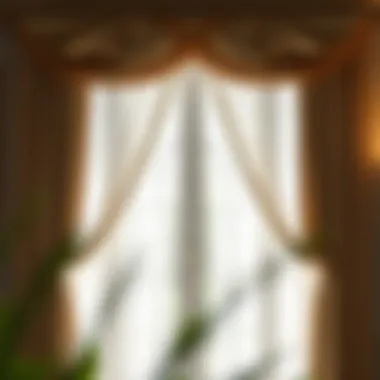
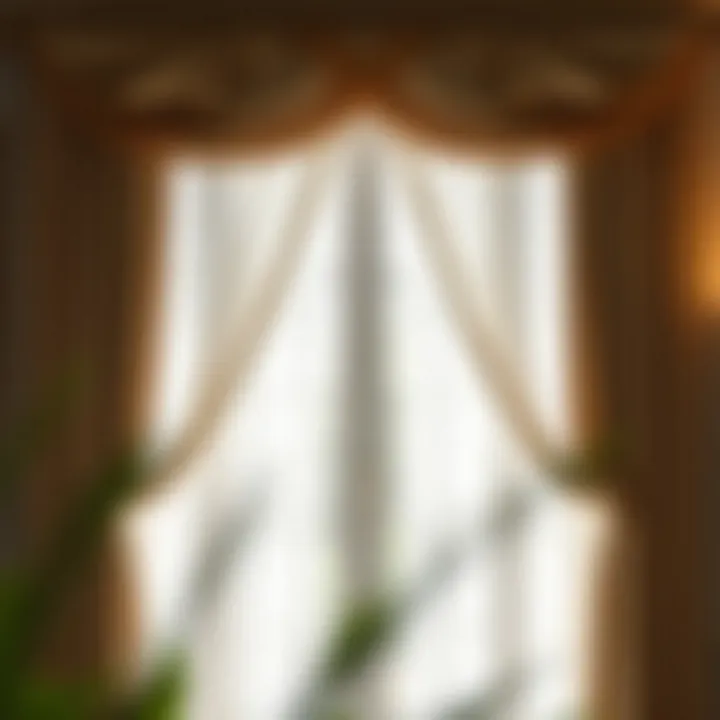
Intro
Choosing curtains for a wide window measuring 12 feet across is no small feat. It’s like trying to find that perfect pair of shoes that not only fits but also makes a statement. With so many options available, it can feel a bit overwhelming. However, selecting the right curtains can dramatically change the ambiance of a space, making it more inviting while addressing practical concerns such as privacy and light filtration.
In this article, we'll explore various styles, materials, and installation methods to suit your expansive window. If you’re ready to find the perfect curtains to complement your home, let's dive into the theme of design inspirations while keeping functionality in mind.
Understanding the Significance of Window Treatments
When it comes to home decoration, few elements have the power to reshape a room like window treatments. Selecting the right curtains for your 12-foot wide window isn't just a task of aesthetics; it also intertwines with functionality, making it an essential decision in interior design.
Curtains serve many purposes. They are not merely pieces of fabric hanging by the window but play a pivotal role in the overall tone and ambiance of a space. When chosen thoughtfully, they can enhance the architectural features of your home, while also providing essential light control and privacy.
To break this down further, here are some important aspects to consider when selecting curtains:
- Aesthetic Balance: Curtains contribute significantly to the visual balance of a room. They can either complement or distract from the room’s design. For a wide window like yours, proper curtain selection can become a statement piece, serving as the central focus of the space.
- Light Management: The size of your window makes light control paramount. Curtains can either filter in soft natural light or completely block it. This is crucial, especially in rooms where certain moods are desired, or where the harsh afternoon sun can sometimes be too much.
- Privacy Needs: Given that this is a large window, privacy becomes a serious consideration. Choosing the right fabric and curtain type can ensure that you maintain your personal space without sacrificing style.
- Energy Efficiency: Opting for heavier fabrics can also have insulating properties, keeping your home cooler in summer and warmer in winter. This can play a vital role in reducing energy costs, making your choice practical as well as stylish.
In summary, understanding the significance of window treatments is about exploring their impact on functionality and design. The curtains you choose can bring personality to your space while meeting practical needs.
"The curtain is the silent storyteller of our homes, speaking volumes about our tastes and needs without uttering a single word."
By recognizing this, you set the stage not just for visual appeal but for creating comfortable, functional living spaces that reflect your vision and lifestyle.
Measuring Your 12-Foot Wide Window
Measuring your 12-foot wide window is not just another cheeky task; it is a crucial step in selecting the right curtains that will enhance both functionality and aesthetics of your space. Getting accurate measurements ensures the curtains you choose will hang properly, provide optimal light control, and fit within your budgets and design vision. A miscalculation could leave you with curtains that either fall short or drag along the floor—neither of which are palatable scenarios.
Proper Measurement Techniques
To start off, you need to gather the right tools: a measuring tape, a notepad or a smartphone to jot things down, and maybe even a trusted buddy to help out from a different angle. When measuring a window that spans 12 feet, precision is key. Here are some steps to guide you:
- Height Measurements: First, measure the height from the top of the window frame to the bottom. Usually, curtains look better when hung higher, extending from a few inches above the frame towards the floor.
- Width Measurements: For width, measure from one end of the window frame to the other, then add additional inches if you plan to mount your rods wider than the window frame. This allows the curtains to fully smarten your window and maximize light control.
- Depth Considerations: If you are also considering curtain depth (for example, mounting the rods in front or inside the frame), measure the depth of the frame too. Not all windows are cut from the same wood, rewarding different mount styles.
- Identify any Obstructions: Take note of nearby fixtures such as radiators, furniture, or architectural features that might interfere with curtain placement. This is often an overlooked but essential aspect that can affect how you measure.
By following these measurement techniques, you're setting the groundwork for a well-fitted curtain selection that complements your 12-foot wide window, rather than fighting against it.
Understanding Curtain Rod Placement
Now you’ve measured everything; the next big game is understanding where to place the curtain rods. Rod placement can influence the overall look of your curtains and the atmosphere of the room. Here are key points to consider:
- Above the Frame: Mounting your rods above the window frame is a strategic move that can make your ceilings look taller and your space feel more open. It also allows you to pull the curtains back strongly, letting in maximum light when needed.
- Width Beyond the Frame: A common practice for larger windows, like your 12-foot beauty, is to extend the rod at least another 6-12 inches on each side. This creates an illusion of a wider opening and can make the curtain treatment feel more luxurious.
- Brackets Distance: When installing curtain rods, ensure that the brackets are placed approximately 4-8 inches from the edges of the window to provide some cushion for the fabric. This prevents the curtains from bunching awkwardly around the corners.
By grasping the fundamentals of both measuring and understanding rod placement, you ensure your curtains deliver style and function without a hitch. In the grand scheme of window treatments, this preparation work is half the battle and pays off in the long run with a polished appearance and satisfied aesthetic.
Choosing the Right Curtain Style
Choosing an appropriate curtain style for a 12-foot wide window can be a game-changer in your overall interior design scheme. Windows of this size can easily become a focal point in a room; hence, selecting the right curtains not only serves functional purposes but also brings in a broad aesthetic appeal.
When you choose your curtains wisely, they can enhance the ambiance of your space, control natural light, and provide the privacy you desire. The right style will help pull the room together, complementing existing furniture and decor while also aligning with your personal taste. This leads us to explore various curtain styles available in the market.
Panel Curtains vs. Drapes
Panel curtains and drapes often get tossed into the same basket, yet they offer distinct characteristics that suit different needs. Panel curtains usually come in lighter materials, making them ideal for a casual, airy look. They glide easily along a rod, allowing for flexible light control. Perfect for a large window, their simplicity often gives a clean and modern feel.
On the other hand, drapes are usually crafted from heavier fabrics, providing a more formal touch. They often come with linings for extra warmth and light blockage. If you have a large window, drapes can create a dramatic effect, drawing the eye and giving an impression of grandeur. It’s worth taking a moment to weigh these choices based on the vibe you want to create in your space.
"The right curtain choice turns a plain window into the star of the show."
Valances and Their Applications
Valances serve as an elegant top treatment for your curtains. They add a stylish flourish without overwhelming the space. Think of them as the cherry on top of a well-crafted dessert. Valances pair beautifully with longer curtains, breaking up the vertical space in a balanced manner. They can help soften the harsh lines of a wide window, creating an inviting atmosphere.
Furthermore, valances can provide a chance to introduce a touch of color or pattern, making them functional and decorative. When you consider valances, think about how they can cascade elegantly with your main curtains or act as a standalone piece, drawing the eye upward and making that 12-foot expanse feel even more significant.
Layering with Sheers
In the world of window treatments, layering is a technique that has stood the test of time. By incorporating sheer curtains, you allow soft light to filter through while maintaining some level of privacy. Combining sheers with heavier curtains adds depth and dimension to your window, enriching the visual interest.
With a wide window, layering can be particularly beneficial. It can transition the look from day to night, offering versatility. During the day, let the sheers catch the sunlight and create a gently illuminated room. At night, draw the heavier curtains for privacy. This dual functionality makes layering an appealing option for homeowners looking for both style and utility.
Selecting Materials for Your Curtains
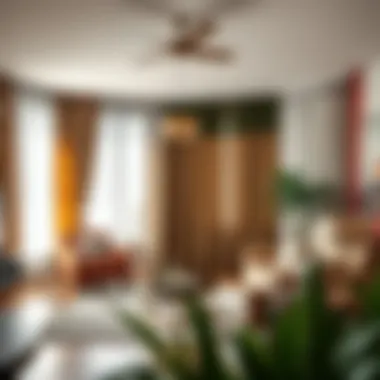
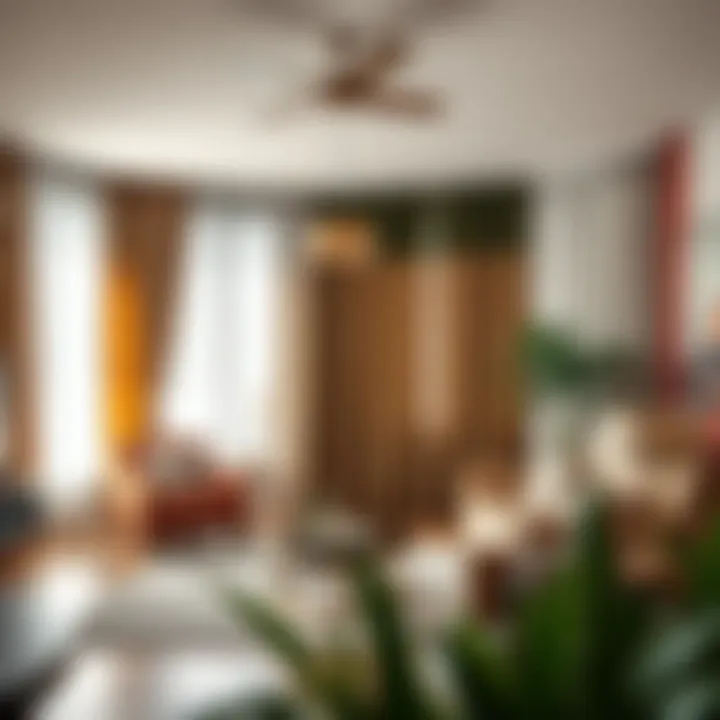
When it comes to dressing your 12-foot wide window, the material of your curtains can greatly influence both the aesthetic and functional dynamics of your space. Not only do materials add texture and tone, but they also play a significant role in how light filters in, how privacy is maintained, and even how energy-efficient your home can be. Choosing wisely means considering elements like durability, maintenance, and how the fabric interacts with sunlight, as well as how it complements your overall design scheme.
Natural Fabrics: Linen and Cotton
Natural fabrics such as linen and cotton are celebrated for their aesthetic beauty and organic feel. Linen, with its crisp texture and sophisticated look, brings a sense of elegance. It drapes well, making it ideal for both formal and casual settings. However, it does tend to wrinkle easily, which might not suit everyone's taste. Cotton, on the other hand, comes in various weaves and finishes, making it a versatile choice. It's also quite breathable, allowing for natural light without compromising privacy. Both materials are easy to clean, often machine washable—though double-checking label instructions is wise.
Among the benefits of using natural fabrics:
- Breathability: Great for regulating temperature.
- Eco-Friendly: Often sustainably sourced, making them ideal for environmentally-conscious homeowners.
- Aesthetic Versatility: Colors and prints can easily blend into diverse decor styles.
Synthetic Options: Polyester and Blends
For those seeking a durable solution, polyester and blends with other fibers offer a practical alternative. Polyester curtains are often more resistant to fading, mildew, and wrinkling compared to natural fabrics. This makes them particularly well-suited for areas where sunlight is abundant, as they maintain their color and shape better over time. Additionally, synthetic options can be made to mimic the texture and look of more high-end materials without the hefty price tag.
Synthetic fabrics can offer:
- Durability: They stand up better to wear and tear.
- Cost-Effective: Typically, they are more budget-friendly than natural fibers.
- Variety of Designs: Available in an array of colors, patterns, and textures, offering ample choice for any design vision.
Choosing Weight and Opacity
Curtains come in various weights and levels of opacity, which can significantly affect the ambiance of a room. Lighter fabrics often allow for a soft diffusing of light, creating a warm, inviting atmosphere. Conversely, heavier materials tend to block out more light while providing greater insulation and privacy. This can be especially important in a large room with a wide window, where the amount of incoming light can greatly influence the overall mood.
When selecting your curtain weight and opacity:
- Consider usage: Are the curtains primarily for decoration, or do they need to function as blackout curtains?
- Room specifics: Think about the room’s purpose—living rooms may benefit from lighter fabrics, while bedrooms might require thicker, darker options.
- Seasonal change: How might you adapt the materials for different seasons? A light linen in summer and heavier polyester in winter might provide flexibility.
"The right materials can transform your curtains from just functional pieces to beautiful elements of interior design."
In summary, the choice of material in your curtains is pivotal in determining not only the look of your space but also how it feels and functions. Whether you lean towards the elegance of natural fibers or the practicality of synthetics, understanding the nuances of fabric choices will help you make an informed decision for your expansive window treatment.
Color and Pattern Considerations
Choosing the right colors and patterns for curtains can become a pivotal part of your interior design strategy, especially for broad windows like a 12-foot wide one. The aesthetics of a space can dramatically shift simply by the hues draping across a window. Color not only determines the mood of the room but also influences how light interacts with the space, which is crucial in open areas. Patterns, on the other hand, can bring depth and character to an otherwise understated environment.
Solid Colors and Their Effects
Solid colors can create a striking impact in a room. The choice of a single hue can set the tone, from cozy and warm to cool and serene. For a 12-foot window, deep colors like navy blue or forest green can lend a sense of intimacy to an expansive area. Conversely, light shades such as off-white or soft pastels can help to make the space feel airy and open.
When selecting a solid color, it’s vital to consider how it interacts with the existing décor. Here are several points to consider:
- Complement Existing Colors: Make or break the room's balance. If the walls are painted a neutral tone, a bold color can create a stunning focal point.
- Consider Lighting: A color might appear different in natural light versus artificial lighting. Move around in the room to see how the light shifts throughout the day.
- Mood Influence: Dark colors can feel dramatic and cozy; light colors can promote a feeling of expansiveness.
Using Patterns to Enhance Design
Patterns can inject vibrancy into a room, especially beneficial in a large window setting. A well-chosen print can draw the eye and create focus. Whether you opt for geometric designs or florals, keep in mind that the scale of the pattern should be appropriate for the size of the window and surrounding space. Here are some considerations when using patterns:
- Scale Matters: Large scale patterns can overwhelm and feel chaotic on a broad surface unless balanced correctly.
- Creating Cohesion: Try to incorporate elements from the pattern into other parts of the room, like throw pillows or rugs to create coherence.
- Experiment Carefully: Mixing different patterns can yield dynamic results, but it’s essential to do so with balance in mind, maintaining a consistent color palette.
"Choose patterns that not only excite but also preserve a sense of unity within your decor."
Balancing Shades in Large Spaces
When dealing with a wide window, balancing shades effectively becomes an art form in itself. The challenge lies in maintaining visual continuity while still introducing depth. It's beneficial to think about how different tones play together within the space. Here are some strategies:
- Layering Techniques: Combine various shades of the same color to create layers. For instance, using a light grey curtain paired with a darker shade can add dimension to the room.
- Integrate with Furnishings: Consider how the curtains will relate to other large features in the room, like furniture. If the sofa is a rich burgundy, consider lighter curtains to brighten the space.
- Texture Play: Texture can make color more dynamic. Mixing materials, such as sheer panels with a heavier drape, can create an intriguing visual interplay.
In summary, when selecting colors and patterns for your 12-foot wide curtain setup, aim for a balance that transforms your space while reflecting your personal style. With thoughtfulness in choice, you can enhance not only the aesthetic quality but also the emotional warmth of your domestic environment.
Installation Methods
Using a Curtain Rod vs. Track System
Deciding between a curtain rod and a track system is a fundamental choice in curtain installation. Each method has its own set of advantages.
- Curtain Rods:
- Track Systems:
- With a curtain rod, your curtains can be opened and closed smoothly. They are often more visually appealing, offering a decorative element that can enhance the room's style.
- Rods usually come in various materials, such as wood, metal, or composite. This variety allows you to choose a rod that fits the overall aesthetic.
- Installation is straightforward, suitable even for DIY enthusiasts, as it typically requires just a few screws and brackets.
- Unlike rods, track systems offer a more streamlined look and work well for larger windows. They can be less obtrusive, allowing the curtain fabric to take center stage.
- Tracks enable curtains to slide effortlessly. This feature is particularly beneficial if you have heavy drapes or if the curtains need to be moved often, as they don't snag like curtain rings can.
- They are frequently used in conjunction with pinch pleats, which create a more tailored appearance.
Ultimately, the decision comes down to personal preference and the specific requirements of your space. You might prefer a rod for its decorative appeal or lean towards a track system for functionality.
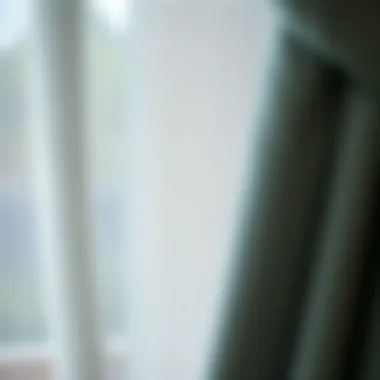

Mounting Considerations for Wide Windows
Installing curtains on a wide window presents unique challenges that you may not face with smaller openings. Proper mounting is essential for both aesthetic appeal and practicality. Here are key factors to keep in mind:
- Width of the Curtain Rod: For a 12-foot window, the rod should extend beyond the window frame. This not only improves light control but also allows curtains to stack neatly to the sides, maximizing your view.
- Support Brackets: Longer rods may need additional support brackets to prevent sagging. This is especially true for heavy fabrics. Ensure you position these brackets appropriately for a secure installation.
- Center Support: Consider adding a center support bracket if the rod is particularly long. This helps to distribute the weight evenly and enhances the curtain's durability.
- Height of Mounting: Mounting the rod higher than the window frame creates an illusion of height, which is especially beneficial in rooms with lower ceilings. Positioning the rod close to the ceiling allows the curtains to gracefully elongate the space.
- Walls and Ceiling Compatibility: Ensure that the mounting surface is stable and capable of supporting the weight of the curtains and the rod or track. This may involve using wall anchors or securing to studs, especially in drywall constructions.
Proper installation of your curtains not only enhances their functionality but also elevates your decor, making it integral to your design considerations.
Maintenance and Care for Curtains
Taking proper care of your curtains goes beyond the mere aesthetic aspect; it can significantly prolong their lifespan and maintain their functional benefits. Curtains, especially for large windows, can be a considerable investment. Therefore, understanding how to maintain and care for them is essential for keeping your living space looking its best and maximizing your return on investment.
Cleaning Techniques for Different Fabrics
Different curtain fabrics require distinct cleaning protocols to ensure they retain their beauty and functionality. Here’s a breakdown of common materials and corresponding cleaning methods:
- Linen: This fabric is delicate, and cleaning should be gentle. Use a mild detergent and lukewarm water. Hand-wash if possible, or use the gentle cycle on your washing machine. Always air dry them to avoid shrinkage.
- Cotton: Cotton tends to be more forgiving. Usually, you can machine wash it, but make sure to read the care label. Hot water can cause colors to fade, so it’s safer to stick with cold water for dark or bright colors.
- Polyester: This synthetic fabric often stands up well to machine washing. Wash in warm water and tumble dry on low heat. They usually resist wrinkles, but a low iron can help with any creases.
- Silk: This fabric is luxury, but it’s also very tricky to clean. Dry cleaning is recommended for silk curtains to avoid any damage or shrinking.
Tip: For all types, consider removing dust with a handheld vacuum cleaner or a lint roller once a week to keep them fresh between washes.
Preventing Fading and Wear
Over time, curtains can fade due to sun exposure or become worn from frequent handling. Here are some strategies to keep your curtains looking as good as new:
- UV Protection: Look for curtains treated with UV resistant coatings. These can help minimize fading from direct sunlight. Additionally, consider using sheer curtains beneath heavier drapes to filter sunlight without blocking it completely.
- Proper Hanging: Ensure that curtains aren’t dragged on the floor if they are floor-length. This unnecessary friction can lead to wear and tear.
- Mind the Environment: If you live in areas with extreme weather, keeping curtains closed during intense heat or storms can mitigate wear. Likewise, maintaining stable indoor humidity can preserve fabric integrity.
- Rotate and Alternate: For frequently used rooms, consider alternating your curtains by changing them out seasonally. This distributes wear more evenly.
By following these simple yet effective maintenance tips, you can ensure that your curtains not only elevate your room’s ambiance but also remain in optimal condition for years to come.
The Role of Curtains in Energy Efficiency
When it comes to managing energy consumption in your home, the role of curtains cannot be understated. For a broad window, like one that spans 12 feet, the choice of window treatments can greatly influence not only the aesthetic appeal of a room but also its energy efficiency.
Insulating Properties of Curtains
Curtains serve as a barrier against outside elements, and this insulation effect is particularly important for larger windows. When you select curtains with thicker materials, such as heavy drapes or thermally-insulated fabrics, you aid significantly in regulating indoor temperatures. This helps keep your home cooler during hot months and warmer when the cold sets in. A well-insulated curtain can reduce heat transfer, which means less reliance on heating and cooling systems.
Here are some key features to consider when assessing the insulating properties of curtains:
- Material: Fabrics such as velvet and lined cotton not only block light but also effectively insulate against temperature fluctuations.
- Thickness: Thicker panels provide more insulation. Consider double-layered curtains for even better performance.
- Length and Width: For wider windows, ensure that the curtains extend beyond the edges; this prevents gaps where air might escape.
By having proper insulation, your home can maintain a steady temperature, leading to reduced energy usage and lower utility bills.
"In a well-insulated room, the thermostat can often stay a degree or two higher or lower without compromising comfort."
Light Control and Temperature Regulation
Another integral feature of curtains is their ability to regulate light, which directly affects indoor temperatures. The control of sunlight entering your space helps not just in setting the mood but in managing energy use as well. Bright sunlight pouring in through the window can cause temperatures to spike, leading many homeowners to crank up the air conditioning.
To optimize light control, consider the following approaches:
- Light-Filtering Fabrics: These allow natural light to enter while diffusing it, helping reduce glare without overheating the room.
- Blackout Curtains: Perfect for rooms requiring complete darkness and temperature control like bedrooms; they can keep warmth from escaping during colder months.
- Layering Techniques: Combining sheer panels with heavier drapes provides flexibility. During the day, you can keep sheers drawn to allow light while closing the heavy drapes at night.
In sum, curtains do more than just dress up a window; they play a critical role in enhancing energy efficiency. By selecting the right materials and styles, you can significantly improve your home's temperature management, ultimately having a positive impact on your energy consumption.
Custom Curtains and Professional Installation
When it comes to dressing a 12-foot wide window, the choice between custom curtains and ready-made solutions can significantly affect both the functionality and aesthetics of your space. Custom curtains allow for a perfect fit and design that resonates with your personal style, while professional installation ensures these selections are executed with precision and care. This section will elaborate on the compelling reasons to consider bespoke options and the importance of hiring skilled installers.
When to Opt for Custom Solutions
Custom curtains are not just a whim; they serve as a strategic choice, especially for expansive windows like a 12-foot-wide window. Here are some pivotal reasons why custom could be your best bet:
- Exact Fit: Standard sizes often fall short when it comes to larger openings. Custom curtains are tailored precisely to your measurements, eliminating awkward gaps or excessive fabric that often plagues off-the-shelf options.
- Personal Style and Fabric Choices: With a custom approach, the world is your oyster. Want that rare shade of aqua or a unique pattern that matches your grandmother's vase? You can choose any fabric, color, or design that reflects your personal flair.
- Window Treatment Complexity: Some windows have unique shapes or angles that standard curtains just can't accommodate. Custom solutions ensure you can dress those tricky corners or create dramatic floor-to-ceiling looks without a hitch.
- Upgraded Functionality: Custom curtains can incorporate specific features tailored to your needs, such as blackout lining, thermal insulation, or even motorized options for added convenience.
In summary, when you want your window treatments to make a statement while serving their objective in practical ways, turning to custom options becomes beneficial.
Choosing a Professional Service
Once you've decided on custom curtains, the next logical step is finding a professional who can bring your vision to life. A well-installed curtain system can transform a room's aesthetic and functional quality. Here's what to consider when selecting a professional service for installation:
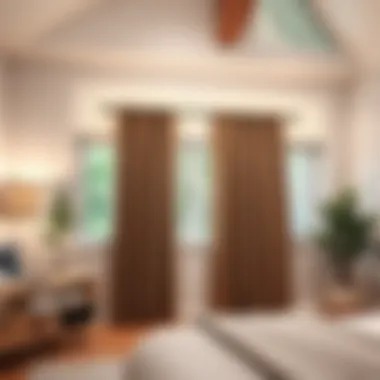
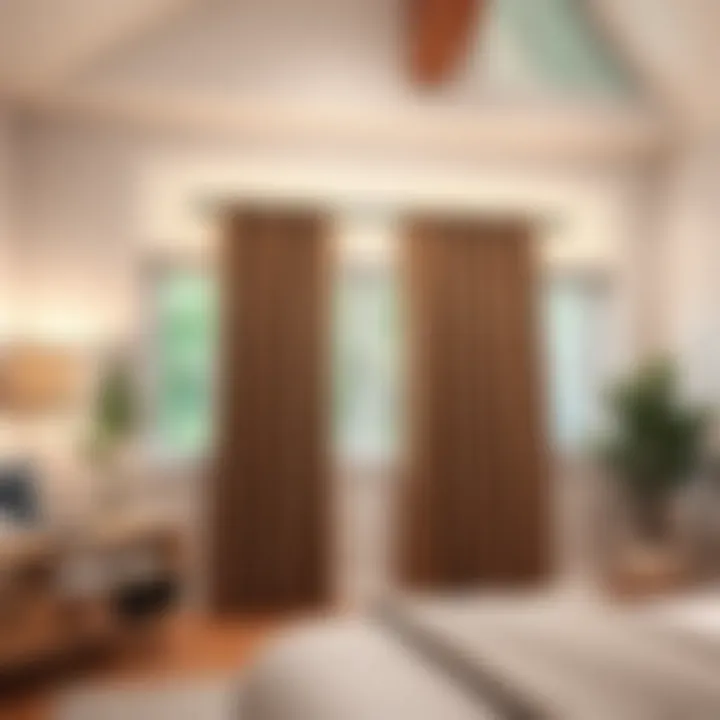
- Experience Matters: Look for installers who have a solid track record with large window treatments. Their expertise will guide you through the nuances of proper drapery measurements, hardware choices, and mounting specifics.
- Client Reviews and References: Dive into feedback from previous clients. A portfolio showcasing their past work or testimonials can give insight into their reliability and quality. Don't hesitate to ask for references; a satisfied customer can tell you everything you need to know.
- Detailed Estimates: Be wary of vague pricing. A detailed estimate will include materials, labor, and any other charges that may pop up. This transparency allows you to budget accurately, avoiding nasty surprises down the line.
- Aftercare Services: Some installers also offer maintenance or care tips post-installation. This can be a valuable resource, especially for intricate designs or high-maintenance fabrics.
To conclude, investing in custom curtains and their professional installation is about making informed choices, ensuring your living space not only looks appealing but works well with your lifestyle. Stressing the importance of quality, both in fabric and installation, will pay dividends in overall satisfaction with your window treatments.
Budgeting for Curtains
Establishing a budget helps define the realm of possibilities. It’s not just about setting a maximum price but understanding the costs involved at multiple levels. Variables such as fabric type, curtain styles, and the need for custom designs can all lead to a wide range of prices. By approaching the budgeting process thoughtfully, homeowners can find options that meet their aesthetic desires and functional needs without wreaking havoc on their wallets.
Understanding Cost Factors in Curtains
The cost of curtains can vary widely based on several key elements. First off, the fabric itself can be a game changer in terms of price. Natural fabrics like silk or linen usually carry a premium compared to synthetic materials such as polyester or blends. When selecting for a large window, the total fabric requirement will compound the cost as well. For instance, a 12-foot wide window often needs ample fabric to create folds and fullness, which can double or even triple the material costs.
Moreover, the style and design of the curtains can sway your budget. Custom drapes that are tailored to fit specific measurements typically cost more than ready-made options found in stores. Let’s not forget about the hardware, either—quality curtain rods, brackets, and other mounting accessories have their own range of prices.
Lastly, consider the installation costs. Will you do it yourself or hire a professional? DIY can save a boatload of cash, but it does require time and know-how. Hiring a pro ensures a polished look, especially for a wide window like yours.
Finding Affordable Options
Affordability doesn’t mean you have to compromise on style or function. Here are some tips to keep the budget in check while still getting the curtains you desire:
- Shop Sales and Clearance: Seasonal sales are a gold mine for budget shoppers. Keep an eye out for discounts around holidays and seasonal changes.
- Consider Ready-Made Curtains: While custom options are tempting, ready-to-hang curtains often look great and cost much less.
- DIY Updates: If you find a fabric you love but it's out of budget, consider making your own simple curtain panels. There are plenty of online tutorials that can guide you.
- Mix and Match: Use high-end fabrics for small sections and combine them with more affordable choices for the rest. This layering technique can add dimension without breaking the bank.
- Reuse: If you're redecorating, see if existing curtains can be repurposed or adapted for the new space.
By being strategic and creative, you can fit your 12-foot window with curtains that don’t just look good but also fit snugly within your budget, proving that elegance needn’t cost a fortune.
Innovative Trends in Curtain Design
When contemplating the selection of curtains for a 12-foot wide window, one must not overlook the impact of modern trends that intertwine functionality with cutting-edge aesthetics. Innovative trends in curtain design have risen to prominence, reflecting shifts in technology, lifestyle, and environmental consciousness. These elements not only enhance the visual appeal of your space but also improve its practicality, making them essential considerations for any homeowner or interior design enthusiast.
Contemporary curtain options often go beyond the traditional fabric hanging. They integrate smart technology that caters to the fast-paced, tech-savvy lifestyles many lead today. This trend in smart curtains not only emphasizes convenience but can also boost energy efficiency. For curtains to be truly effective in modern designs, they need to complement the technological advancements in the home while maintaining an eye-catching look.
Furthermore, sustainability has emerged as a guiding principle in design choices. Homeowners are increasingly looking for materials that are eco-friendly, reflecting a growing concern for the planet. This link between design and environmental responsibility affects buying decisions, spurring demand for curtains produced from sustainable resources without sacrificing style or quality.
With that said, it’s paramount for those investing in their living spaces to stay informed about the latest trends. By being in the loop, they can make selections that not only beautify their homes but also align with their values and lifestyle preferences.
Smart Curtains and Technology
Smart curtains represent a significant leap forward in interior design. Their integration into homes has provided a new realm of convenience and efficiency. Imagine walking into a room where the curtains draw back automatically as the sun rises or at the command of a smart assistant. This feature not only enhances the ambiance but also ensures an optimal level of natural light throughout the day.
The technology behind smart curtains typically involves materials that can be controlled remotely via smartphone apps, voice commands, or scheduled timers. Such functionality is especially valuable for large windows, like the 12-foot wide variety, as it can be cumbersome—if not impossible—to manually operate heavier fabric.
In addition to convenience, smart curtains can significantly improve energy efficiency by regulating the amount of heat entering the room. This is especially critical for larger windows that may lead to heat loss or gain. According to various sources including energy.gov, proper window treatments can save homeowners upwards of 30% on heating and cooling costs.
"Window treatments are a quiet hero in the quest for energy efficiency; they don’t just serve aesthetics, they play a crucial role in temperature regulation.”
The addition of smart technology in curtains allows for automatic adjustments based on external temperature, optimizing energy use effectively. In sum, incorporating smart curtains in your design not just meets functional needs—it can also add a touch of luxury to your home environment.
Sustainable and Eco-Friendly Materials
The increasing emphasis on eco-friendly designs is hard to miss. Homeowners today are not just interested in how a product looks; they also care about its impact on the environment. This growing consciousness gives rise to a demand for sustainable and eco-friendly materials in curtain designs.
Here are some options that are making waves in this area:
- Organic Cotton: Grown without the use of harmful pesticides, this material is not only better for the planet but also softer on the skin. Organic cotton curtains often have a durability that maintains their appeal through the years.
- Bamboo Fabric: This is another remarkable choice that comes from a rapidly renewable source. Bamboo curtains add a chic, natural look to spaces while being biodegradable.
- Recycled Polyester: Curtains made from recycled materials not only help reduce waste but also provide easy-care benefits, making them an ideal choice for busy households.
When selecting eco-friendly materials, it's essential to also consider factors like how the material was sourced and the manufacturing processes involved. Opting for curtains that align with sustainability values provides homeowners a sense of purpose in their design choices.
Finale and Final Thoughts
Selecting the perfect curtains for a 12-foot wide window is not merely about aesthetics; it's also about functionality and creating the right atmosphere in your space. Throughout this article, we've unpacked critical elements including style choices, materials, installation techniques, and the ever important aspects of light control and privacy. Understanding these factors not only elevates the visual appeal of your room but also contributes to comfort and energy efficiency.
When it comes to such a broad window, it's essential to consider the flow of natural light and how it interacts with your decor. Choosing the right fabric can either enhance or hinder the light quality that pours in. Remember that heavier materials can create a luxurious feel while lighter fabrics might evoke a sense of airiness. Furthermore, ensuring that your curtains fit well can play a critical role in insulation, not just for temperature but also for sound.
"Curtains are the frame to your window; treat them as such."
By thoughtfully assessing your options, you can select curtains that harmonize with your room’s color scheme and overall design theme, without skimping on practical elements.
In summary, the journey to selecting the right curtains is filled with choices, but also rewards—the right decisions can transform your space from ordinary to extraordinary.
Recap of Key Points
- Measurement Precision: Always measure carefully, ensuring that your curtains will provide the maximum coverage without being too short or overwhelming.
- Material Matters: Choose the fabric that complements your lifestyle—think about maintenance and durability.
- Style Variations: Whether opting for panels, drapes, or sheers, each style carries a unique charm that should resonate with the room's vibe.
- Light Control: Curtains play a vital role in modulating light, fostering a cozy environment while protecting your furnishings.
- Installation Insight: Understanding mounting options and their implications on the window layout is crucial to achieve an ideal look.
Encouragement to Experiment with Design
Don't be afraid to take some creative leaps when selecting curtains for your 12-foot window. Design is a personal expression, and what works best is often influenced by individual taste. Here are some ideas to get those creative juices flowing:
- Mix Textures: Combine different fabrics or curtains, such as sheer and opaque, to achieve complexity in appearance.
- Bold Patterns: Sometimes, a striking pattern can add character and depth to your space, allowing for more subdued furniture to shine.
- Layer Up: Consider layering with different lengths or styles; for instance, sheer panels under heavier drapes can create versatile lighting options.
- Play with Color: Don’t shy away from bold colors that can make a statement or soft hues that provide calmness.
In the end, your choice should reflect your lifestyle, preferences, and the overall mood you wish to set in the space. So, roll up your sleeves and start experimenting—your ideal curtain design is waiting to be uncovered!







